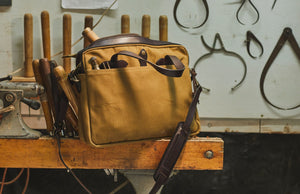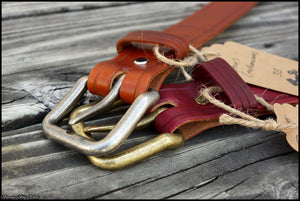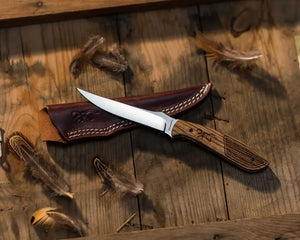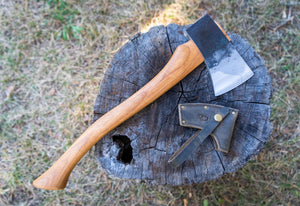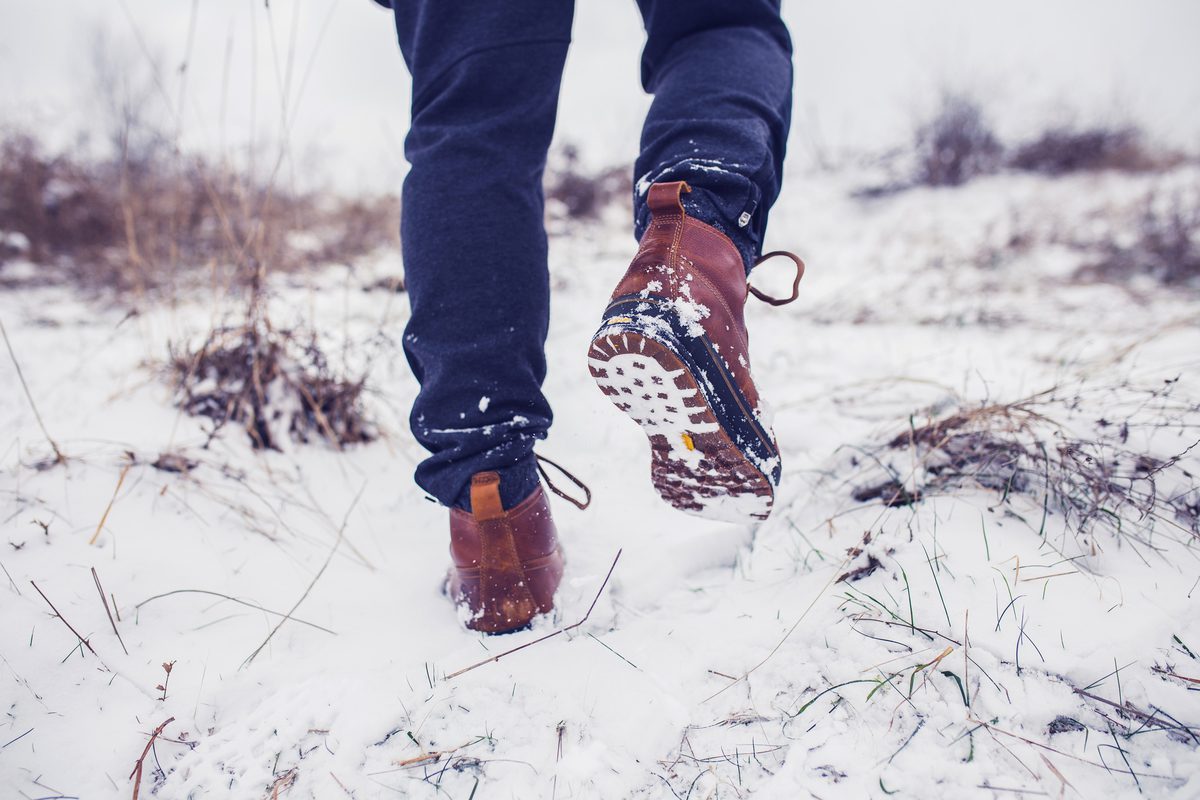
Leather, Suede & Everything In-Between: How to Waterproof Your Work Boots
Your boots were made for walking. Let them take you where you need to go—across dewy fields, flowing streams, muddy paths, parking lot puddles or snow—while keeping your tootsies nice and dry.
Why settle for soggy toes? Give your boots a not-so-secret superpower with a water-resistant shield. Follow these tips on how to waterproof your outdoor work boots for winter weather, hiking adventures or everyday use. Observe these steps, whether you're treating leather boots out of the box or giving your trusted hiking boots a fresh application after months of wear.
This quick guide to waterproofing boots covers the following:
- Cleaning Your Work Boots
- Waterproofing Your Work, Hiking or Hunting Boots
- Drying Your Boots
- How Often You Should Waterproof Your Boots
- Best Products for Waterproofing Boots
Cleaning Your Work Boots
Dirty boots are a fact of life. Working at construction sites, ranches or the family farm takes a toll on your footwear. Do you clean your boots regularly? Or do you leave them dirt-caked on the porch or in the garage?
Boots must be clean before adding a coat of waterproofing wax or spray-on treatment. Left-behind dirt and mud get in the way of the water-repellent coating. Dirt stops waterproofing products from fully penetrating the material.
Here’s how you should clean your boots:
- Remove the laces first. If your laces need a quick clean, toss them in the washing machine. You can wash most bootlaces normally, but it's always a good idea to check the manufacturer's recommendations.
- Brush off any dirt and caked mud. You can use a soft-bristled brush to loosen and remove particles.
- Clean with detergent and water. If your boots are exceptionally filthy, you may need to spray them with a hose or let them soak in water for a bit. If you haven’t tramped through inches of mud lately, you can clean your boots with a footwear cleaner to remove dirt smudges. Make sure you use an appropriate cleaner made for the material.
- Rinse and towel dry after you clean your boots with detergent. Waterproofing treatments work best when boots are damp, so don't let your boots fully dry if you plan to apply a waterproofing product.
You should clean your boots regularly, even when you aren’t planning to waterproof them. Every time you take a step, dirt moves farther into the fabric and can slowly break down materials. Mud can even speed up leather aging because it sucks up moisture as it dries.
Waterproofing Your Work, Hiking or Hunting Boots
Many new boots are waterproof straight off the shelf. Wolverine, for example, makes several waterproof work boots that are both comfortable and athletic.
Leather boots are naturally waterproof but still need additional treatment or boot sealer to protect the shoes and your toes. Fabric boots often have Durable Water Repellent (DWR) coatings or special layered membranes to add water resistance.
New boots? You may want to treat them with waterproofing wax, cream or spray right out of the box. If you’ve put many miles on your current pair, save yourself from unwanted water leaks by treating them regularly.
Once your boots are clean, you can apply a waterproof treatment. Then take off on your next adventure!
How to Waterproof Full-Grain Leather Boots
Full-grain leather boots are smooth, shiny and naturally water-resistant. However, they still need to be treated since animal leather is porous. Over time, leather dries out and breaks down. Waterproofing treatments condition leather and help protect the material for lasting wear.
You can waterproof leather boots with whatever product is most convenient for you. Full-grain leather wax, cream and spray treatments are all effective options. The best product for waterproofing leather boots is the one that you actually will use!
Many people stick to the classic treatment for leather—waterproofing wax. Here’s how to wax boots effectively:
- Start with clean, damp boots. Damp leather absorbs waterproofing wax more easily.
- Warm the wax with a hairdryer.
- Use a cloth or rubber gloves to apply the wax to your boots in dime-sized drops.
- Massage the wax into the leather in a circular motion and spread it evenly over the surface of your boots. Work the wax into the boots' seams, creases and edges to prevent future leaking.
- Remove any excess wax with a cloth and repeat. Grangers recommends applying 2-3 thin coats of their waterproofing boot wax.
- Let the boots air dry.
Sometimes waterproofing products darken leather. You can test the product in a small spot to see its effect, but you should expect your boots to change color slightly after treatment.
How to Waterproof Suede or Nubuck Leather Boots
Waterproofing suede hiking boots or nubuck leather shoes requires a different tactic. Both of these materials are slightly less durable than full-grain leather. Wax treatments can stain and damage the soft, brushed finish of suede and nubuck leather.
Many suede and nubuck leather shoes have breathable, waterproof membranes that treatments could damage.
Follow these steps to waterproof rough leather boots:
- Look for a treatment designed specifically for suede, nubuck or “rough” leather. Companies like Danner and Timberland recommend using a waterproofing spray.
- Ensure your boots are clean. Brush off any dirt.
- Apply the spray, holding the can about 6” away from your boots. Cover them with a thin coat.
- Wipe off any excess. Aim for lightly coating the leather, not soaking it.
- Apply additional coats if needed.
- Let the boots air dry.
Spray treatments are less likely to change the color of your boots. Look for a spray that is safe to spray on leather, suede, nubuck and fabric to maximize your investment.
How to Waterproof Synthetic or Fabric Boots
Like suede and nubuck leather, synthetic fabrics shouldn’t be treated with waxes, oils or anything greasy. Those types of treatments can affect the breathability of the fabric. Synthetic materials are non-leather and won't absorb wax treatments like natural materials.
Fabric hiking boots and walking shoes often have Gore-Tex® membranes and are treated with DWR coatings. Gore-Tex® is a man-made waterproof material that deteriorates over time like anything else. Simply cleaning the waterproof membrane can help increase its performance.
If you’d like to go the extra mile, applying spray-on waterproofing treatments helps restore water-repellent finishes and increase the fabric’s longevity.
Drying Your Boots
After treating your shoes, leave them to air dry naturally indoors or in a shaded spot outside. Drying leather boots near a fire or speeding up the process with a hairdryer can cause the leather to crack. Outside, be sure that your shoes are not in direct sunlight. Heat can damage leather.
If you want to help your boots along, you can place them near a cool fan or stuff newspaper inside them to absorb moisture.
How Often Should I Waterproof My Boots?
Over time, waterproof treatments wear off. You’ll know it's time to treat shoes again when they leak or begin to absorb moisture rather than repel it. A good rule of thumb is to treat your shoes every few months.
Boots take a hit from dirt and grime. If you get your boots extremely dirty, clean them off and apply a waterproofing treatment. If you notice water stops beading on the surface of your shoes, that's an indication that you need to restore their water-resistant powers.
Regular waterproofing treatments help keep your feet dry. So go ahead. Cross the stream. Wear your boots in the rain. Let them keep you dry on a misty morning hunt or protected while you put in a day’s work.
Need a new pair of boots? We’ve got you covered. Shop our selection of Wolverine, Danner and DryShod boots online and in store. Live life freely with the right boots for shop floors, farm chores, long hikes and successful hunts.
Enjoying everything the world has to offer starts with happy feet.




